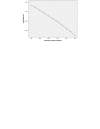Bivariate random-effects meta-analysis and the estimation of between-study correlation
- PMID: 17222330
- PMCID: PMC1800862
- DOI: 10.1186/1471-2288-7-3
Bivariate random-effects meta-analysis and the estimation of between-study correlation
Abstract
Background: When multiple endpoints are of interest in evidence synthesis, a multivariate meta-analysis can jointly synthesise those endpoints and utilise their correlation. A multivariate random-effects meta-analysis must incorporate and estimate the between-study correlation (rhoB).
Methods: In this paper we assess maximum likelihood estimation of a general normal model and a generalised model for bivariate random-effects meta-analysis (BRMA). We consider two applied examples, one involving a diagnostic marker and the other a surrogate outcome. These motivate a simulation study where estimation properties from BRMA are compared with those from two separate univariate random-effects meta-analyses (URMAs), the traditional approach.
Results: The normal BRMA model estimates rhoB as -1 in both applied examples. Analytically we show this is due to the maximum likelihood estimator sensibly truncating the between-study covariance matrix on the boundary of its parameter space. Our simulations reveal this commonly occurs when the number of studies is small or the within-study variation is relatively large; it also causes upwardly biased between-study variance estimates, which are inflated to compensate for the restriction on rhoB. Importantly, this does not induce any systematic bias in the pooled estimates and produces conservative standard errors and mean-square errors. Furthermore, the normal BRMA is preferable to two normal URMAs; the mean-square error and standard error of pooled estimates is generally smaller in the BRMA, especially given data missing at random. For meta-analysis of proportions we then show that a generalised BRMA model is better still. This correctly uses a binomial rather than normal distribution, and produces better estimates than the normal BRMA and also two generalised URMAs; however the model may sometimes not converge due to difficulties estimating rhoB.
Conclusion: A BRMA model offers numerous advantages over separate univariate synthesises; this paper highlights some of these benefits in both a normal and generalised modelling framework, and examines the estimation of between-study correlation to aid practitioners.
Figures
Similar articles
-
An alternative model for bivariate random-effects meta-analysis when the within-study correlations are unknown.Biostatistics. 2008 Jan;9(1):172-86. doi: 10.1093/biostatistics/kxm023. Epub 2007 Jul 11. Biostatistics. 2008. PMID: 17626226
-
An evaluation of bivariate random-effects meta-analysis for the joint synthesis of two correlated outcomes.Stat Med. 2007 Jan 15;26(1):78-97. doi: 10.1002/sim.2524. Stat Med. 2007. PMID: 16526010
-
Univariate and bivariate likelihood-based meta-analysis methods performed comparably when marginal sensitivity and specificity were the targets of inference.J Clin Epidemiol. 2017 Mar;83:8-17. doi: 10.1016/j.jclinepi.2016.12.003. Epub 2017 Jan 4. J Clin Epidemiol. 2017. PMID: 28063915
-
An Empirical Assessment of Bivariate Methods for Meta-Analysis of Test Accuracy [Internet].Rockville (MD): Agency for Healthcare Research and Quality (US); 2012 Nov. Report No.: 12(13)-EHC136-EF. Rockville (MD): Agency for Healthcare Research and Quality (US); 2012 Nov. Report No.: 12(13)-EHC136-EF. PMID: 23326899 Free Books & Documents. Review.
-
Bivariate analysis of sensitivity and specificity produces informative summary measures in diagnostic reviews.J Clin Epidemiol. 2005 Oct;58(10):982-90. doi: 10.1016/j.jclinepi.2005.02.022. J Clin Epidemiol. 2005. PMID: 16168343 Review.
Cited by
-
Analyzing multiple outcomes in clinical research using multivariate multilevel models.J Consult Clin Psychol. 2014 Oct;82(5):920-30. doi: 10.1037/a0035628. Epub 2014 Feb 3. J Consult Clin Psychol. 2014. PMID: 24491071 Free PMC article.
-
Multivariate meta-analysis of critical care meta-analyses: a meta-epidemiological study.BMC Med Res Methodol. 2021 Jul 18;21(1):148. doi: 10.1186/s12874-021-01336-4. BMC Med Res Methodol. 2021. PMID: 34275460 Free PMC article.
-
Performance of methods for meta-analysis of diagnostic test accuracy with few studies or sparse data.Stat Methods Med Res. 2017 Aug;26(4):1896-1911. doi: 10.1177/0962280215592269. Epub 2015 Jun 26. Stat Methods Med Res. 2017. PMID: 26116616 Free PMC article.
-
Multivariate Meta-Analysis of Genetic Association Studies: A Simulation Study.PLoS One. 2015 Jul 21;10(7):e0133243. doi: 10.1371/journal.pone.0133243. eCollection 2015. PLoS One. 2015. PMID: 26196398 Free PMC article.
-
Multivariate network meta-analysis to mitigate the effects of outcome reporting bias.Stat Med. 2018 Sep 30;37(22):3254-3266. doi: 10.1002/sim.7815. Epub 2018 Jun 7. Stat Med. 2018. PMID: 29882392 Free PMC article.
References
-
- Hasselblad V. Meta-analysis of multitreatment studies. Med Decis Making. 1998;18:37–43. - PubMed
-
- Becker BJ, Tinsley HEA, Brown S. Multivariate Meta-analysis. San Diego , Academic Press; 2000.
Publication types
MeSH terms
Substances
LinkOut - more resources
Full Text Sources


